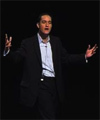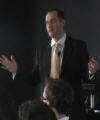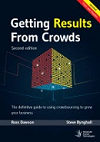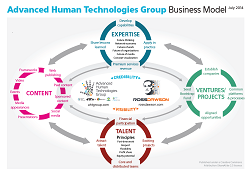Keynote Speaker
Keynote Speaker
Books
In the media
Business Model
Selection of Ross Dawson Frameworks
Video: The Future of Work Framework
Also see our one-page visual of the Future of Work Framework.
Video transcript
UNDERLYING DRIVERS
We are connected as never before. Today 3 billion people are accessing the Internet; 2 billion more will join us over the next 5 years, almost all of them through mobile devices.
Extraordinary increases in processing power are taking us to new frontiers in artificial intelligence, ranging from making sense of language to spatial cognition that enables robots to comfortably navigate the world.
Demographics is driving our future, but that is playing out very differently across countries, leading to migration from young countries to old. Everywhere there is a decreasing ratio of workers to the elderly they need to support.
Society is being driven by increasing expectations across the board, including of opportunity, flexibility, equity, and having a positive impact on the world.
ECONOMIC STRUCTURE
Modularization is reshaping businesses and economies, as activities and business processes are unbundled into discrete, complementary modules, and connectivity drives increasing specialization.
Everything is being globalized, not just products and services, but also research, innovation and eventually almost all organisational functions.
Labor productivity is being driven by technology, but very differently across industries. Lower capital requirements for most businesses are accentuating the value of highly-skilled individuals.
In a connected world polarization risks increasing the divide between those whose capabilities are becoming commoditized and the elite who have world-class specialist knowledge, relationships, or creativity.
LABOR DISPLACEMENT
Almost all work can be performed at a distance, with telepresence and virtual worlds enabling global collaboration, and even machinery and vehicles now operated remotely.
The rise of work marketplaces is making vast pools of talent available to companies. This puts pressure on the pay of lower-skilled workers but provides global opportunities for the most talented.
New crowdsourcing structures are enabling us to effectively tap the minds of many, driving innovation and distilling collective insight.
The reality is that jobs are being rapidly replaced by machines, not just for routine tasks but also for ones involving personal interaction and judgment.
EMERGING LANDSCAPE
We are shifting to an economy of individuals. Independent, entrepreneurial people are creating value by collaborating closely with many others, and building their reputations and networks.
Work opportunities and pay are being polarized, with growth in both low and high-skill jobs but the middle hollowed out. The social risks are immense and we must do everything we can to push back against this trend.
The best performing organisations will be configured as networks, with internal markets for work, extensive use of social technologies, and value creation that transcends the company and spans many external communities.
This leads us to education as the heart of the future of work, with free, openly available resources and peer learning networks helping us to learn continuously and create a prosperous future of work for all.




































